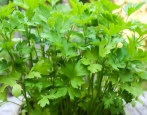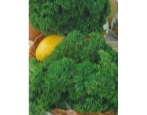
- Year of approval: 2007
- View: sheet
- Leaves length: middle length
- Leaf color: green
- Leaf shape: triangular
- Petiole: middle length
- Petiole thickness: medium
- Petiole coloration: with weak anthocyanin
- Weight of one green plant, g: 75
- Average yield of greens: 2.8 kg / sq. m
Fragrant greens have always been not only a source of useful minerals, but also add playful notes to the taste of a dish. Parsley The Italian giant is characterized by a good harvest and the ability to grow new greens after cutting. As well as ease of care and harvesting.
Breeding history
Parsley The Italian giant is a product of domestic breeding. The originators were the agrofirm "Poisk" and the Federal Scientific Center for Vegetable Growing. The variety was approved for use in 2007.
Description of the variety
Parsley belongs to the leafy type and uses only greens. The Italian giant variety has a number of advantages and disadvantages.
Good taste is noted, while the leaves are juicy and very aromatic. The crop quickly grows green even after repeated cutting. There is immunity to infections and insects, as well as good tolerance to low temperatures. Parsley has excellent yields and can be grown all year round.
The culture has only one drawback, which is noted more often than others - the slow germination of seeds.
Appearance
A large, spreading, semi-vertical rosette grows up to 65-67 cm. The number of leaves is large, from 20 to 25 pieces can form on one branch. They are triangular in shape, with deep lobe cuts. Green or dark green in color. The stems are dense. The petiole is of medium length. Average thickness, color with a weak anthocyanin. By weight, one plant is 75 g.
Purpose and taste
Parsley The Italian giant is used primarily for home cooking. It is used in the preparation of first and second courses, salads, less often it is used for canning. Parsley is frozen or dried, chopped finely.
The aroma of the plant is pronounced, with tart notes.
Ripening terms
In terms of ripening, the culture belongs to mid-season varieties. The growing season takes 90 days. Outdoor harvesting begins in June and can last until October. If the culture is grown at home, then it can be harvested for a whole year.
Yield
Summer residents note a high yield: from 1 m2 can be removed from 2.8 to 3 kg.
Growing regions
The recommended growing regions are as follows:
- Northern;
- Central;
- Northwestern;
- TsCHO;
- North Caucasian;
- Middle Volga;
- Nizhnevolzhsky;
- Ural;
- West Siberian;
- Volgo-Vyatsky;
- East Siberian;
- Far Eastern.
Growing and care
A good yield will depend on several factors. In particular, it is the right choice of location and seed preparation. In warm regions, the Italian giant parsley can be sown 3 times a year: in the spring (from the end of April), in the summer (at the end of July) and in the fall (from October to November).
Seed preparation is as follows. It is necessary to soak the seeds in order to soften the shell and wash out all essential oils. There are several ways to do this:
- soak in hot water at 40 ° C for 2-3 days;
- treat the material with hydrogen peroxide, dipping it into the solution for 20 minutes, then blot everything dry with a napkin;
- soak in alcohol for 10 minutes and then rinse in cool water.
After that, the seeds can be treated with potassium permanganate or aloe juice. To accelerate growth, you can use the drug "Heteroauxin". Before sowing, it is necessary to completely dry the seedlings, otherwise the seeds will stick to the fingers or stick together.
Before sowing, it is necessary to refine the site.Parsley loves a lot of light, so nothing should shade the garden bed. The soil must be dug twice, first in the fall, bringing humus and wood ash into it, and then in the spring. After digging, the ground is leveled and grooves begin to be made at intervals of no more than 20 cm.It is best to plant according to the 10x20 cm scheme.The depth is no more than 2 cm.
All trenches are spilled with warm water and the seeds are sown after all the liquid has been absorbed. Then everything is carefully filled up, and then leveled. To speed up pecking, it is recommended to create a greenhouse on the garden bed. For this, the film is stretched, after the emergence of shoots, it is removed.
Culture care is as follows.
- Loosening the soil. It is necessary to systematically loosen the bed for better air and moisture penetration. The procedure is carried out after heavy rain or watering. Weeds are also removed from the garden as they interfere with growth.
- Thinning. Parsley The Italian giant is very growing. Therefore, some shoots may not receive enough nutrition and sunlight. In this case, it is necessary to choose a scheme according to which the plantings will be thinned out.
- Watering. Moderate hydration must be observed. The soil should not be too wet or too dry. During the rainy season, watering is completely unnecessary.
- Top dressing. It is applied 2-3 times per season. First, nitrogen-containing preparations are selected. Submitted at the beginning of the season. Then the sprouts are fertilized with potassium and phosphorus, nitroammophos. It is not necessary to make fertilizing often, as it can be absorbed too much into the plant and then cause harm when used.







































